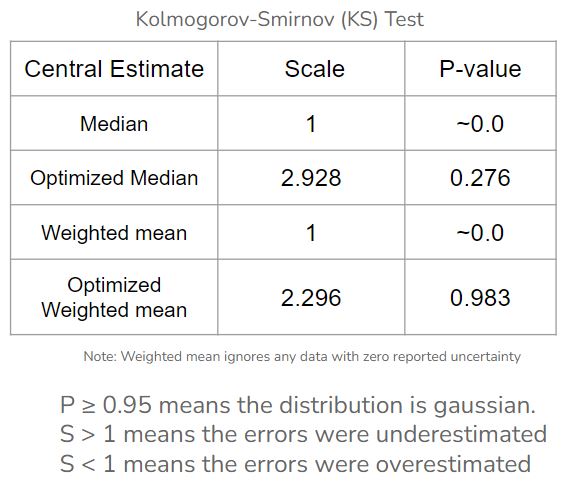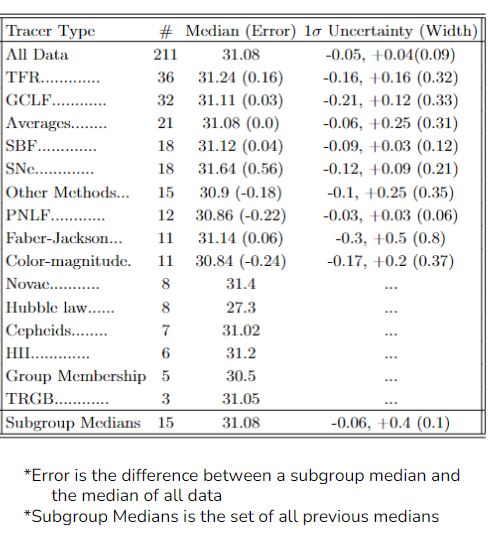A Median Statistics Analysis of the Distance to M87
Nicholas Rackers, Truman State University, Physics & Math Major
Mentored by Dr. Bharat Ratra
There are many different measurements for any number of important cosmological values. It is important to know how to get the best estimate of the true value from many differing measurements. My project this summer, working with Sofia Splawska, was to use a median statistics analysis to compute the best estimate for the distance to M87 as described by Gott et al. [3]
The normal method of estimating true values is typically the mean. However, the mean is very sensitive to outlying measurements. In particular, to conduct a mean analysis we need to make the assumption that the errors are gaussianly distributed. If our data is not so nicely distributed, then the mean will yield some problems as illustrated by Figure 1. However, a median analysis does not assume gaussianity, so it is able to deal with the messy data. Furthermore, we are able to estimate the systematic uncertainties of the data, by dividing the set into tracers.
Fig. 1. Example for how non-gaussianity can lead to misreported means. The Median is less susceptible to skewing but still considers those values while the mean ignores any but the most prevalent.
We used 211 measurements of the distance to M87 compiled by De Grijs and Bono [1] shown in Figure 2. The distance is reported as the distance modulus (M-m) = 5log(d/10) which is effectively a measure of the magnitude of the distance. They organize it into 15 different ways of measuring distance (known as tracers).

Fig. 2. The compiled data organized by year. The very discrepant values from before the 1940s heavily skew a mean analysis.
Using the Median, we are able to construct a probability distribution shown in Figure 3 and apply the data to a Kolmogorov-Smirnov test to check how gaussian it is, the results are shown in Table 1. The assumption is that any random data should follow a gaussian. By optimizing the scale of the errors to maximize the p-value we can tell whether or not the reported errors are over or underestimated. We included the Weighted mean, because if the p-value at unity was greater than 0.95 we would be able to report the Weighted mean (its not).

Fig. 3. The probability distribution of the set of all the M87 measurements. The 1σ region corresponding to 68% of the probability is shown by the red vertical bars. The graph is zoomed into the peak with tails on either side.
Table 1. The p-value table of the given data when tested against a gaussian. The scale factor scales the errors by 1/Scale.
of this yielded us a value for the distance modulus to M87 of 31.08 (+0.04,-0.05, statistical) mag, and the understanding that the errors were likely underestimated as a whole. However, we can go one step further and estimate the systematic uncertainty. Statistical uncertainty is just the randomness of taking data (shown in the width of a gaussian), but the systematic uncertainty is calibration or technical errors of the measurement which evenly affects all or most of the measurements. Each tracer type is subject to a different systematic error, because they are different techniques. So we say that the median of each tracer type is the best estimate of that tracer and is only mildly subject to statistical error. Then we analyze the set of all medians, shown in Table 2, since they are not affected by statistical error, the discrepancies in values is due to the systematic error. This is shown by the subgroup medians row in Table 2. Thus, we can estimate the systematic uncertainty of the estimate.
Table 2. The list of the medians of all the different tracer types. The subgroup medians provides us with the systematic error of the data.
From this analysis we conclude that the best estimate for the distance modulus to galaxy M87 is 31.08 (+0.04,-0.05, statistical) (+0.04,-0.06, systematic) mag.
References
[1]: R. de Grijs and G. Bono, The Astrophysical Journal Supplement Series 246, 3 (2019).
[2]: J. R. G. III, M. S. Vogeley, S. Podariu, and B. Ratra, The Astrophysical Journal 549, 1 (2001).
[3]: G. Chen and B. Ratra, Publications of the Astronomical Society of the Pacific 123, 1127 (2011).
[4]: S. Crandall and B. Ratra, The Astrophysical Journal 815, 87 (2015).
[5]: J. Penton, J. Peyton, A. Zahoor, and B. Ratra, Publications of the Astronomical Society of the Pacific 130, 114001 (2018).
Acknowledgments
Sofia Splawska for working with me. Dr. Bharat Ratra for being our advisor. NSF for the grant.


